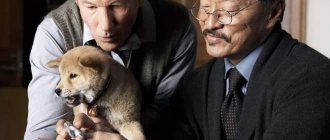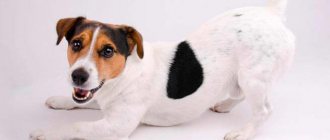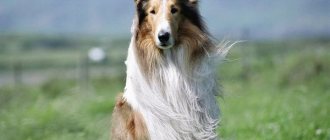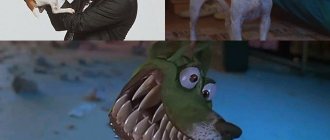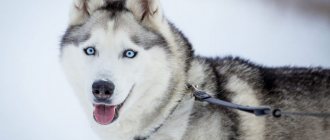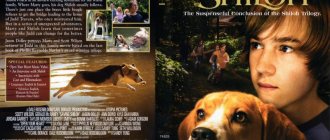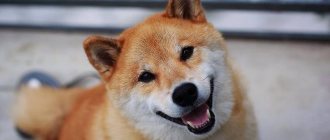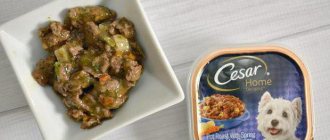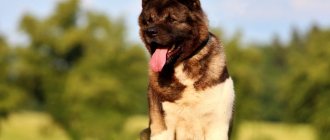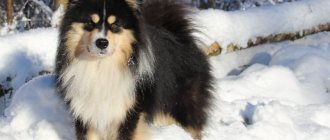In 2013, the third part of the New Year’s comedy “Yolki”, beloved by viewers, was released. New characters appeared in this story: dogs Pirate and Yoko. The new characters harmoniously fit into the plot of the comedy and aroused increased interest among the public. Mainly, the audience had a question: what breed of dogs is from the movie “Yolki”?
It is noteworthy that the mongrel Pirate was played by a dog of noble blood, namely a representative of the border collie breed. And the cute little dog Yoko is a Cavalier King Charles Spaniel.
Let's take a closer look at the history of these selections, the character traits and temperament of dogs.
Let's talk about Yoko: Cavalier King Charles Spaniel breed
Dogs of this breed can be considered “compact” pets, since they have small body sizes and reach a height at the withers of 25 to 30 cm. The weight of an adult spaniel is 4-8 kg.
The Cavalier King Charles Spaniel breed is quite ancient. Back in the 9th century, these dogs were brought to Britain by the Celts, and after 3 centuries they gained unprecedented popularity and are often mentioned in folklore. These cute animals were favorites of the ladies of the court, and were depicted in the paintings of Titian and other popular painters of the time.
There is a legend that one of the representatives of this breed accompanied Mary Stuart to her execution. However, the population received its name in honor of King Charles II, who reigned in the 17th century. He had nothing to do with the direct breeding of the breed, however, it was during his reign that small spaniels were at the peak of popularity.
The dog Yoko from the movie Yolki was played by a Cavalier King Charles Spaniel.
The breed in its current form has existed for no more than 100 years, it was bred by the American breeder Roswell Eldridge. In Britain and Europe, such dogs are common, but in Russia today there are not many kennels where you can buy a Cavalier King Charles Spaniel puppy.
Such dogs are smart and friendly, and also unpretentious in maintenance. A spaniel will become a good friend for a child or an adult, and its main goal will be to communicate with its owner. He will gladly take part in noisy games and will never offend the baby.
These small dogs have good hunting instincts and love to chase moving objects. The Cavalier King Charles Spaniel will happily run after a ball or a thrown stick.
Thanks to the listed qualities, such dogs are perfectly trainable, especially if the owner has developed a reward system in the form of affection and treats with his favorite treats.
There are no barriers to love
Pekingese or St. Bernard, spaniel or Doberman, fox terrier or pointer - it doesn’t matter what breed. The dogs from the film “Yolki 3” once again reminded viewers that for true love there are no barriers or life conventions. This story was included in the third part - the continuation of the films “Yolki” and “Yolki 2”. In December 2013, when the film “Yolki 3” was released, the border collie dog breed gained even more popularity. Although according to the film's script, the dog named Pirate is an ordinary mongrel. His beloved Yoko is a Cavalier King Charles Spaniel with a good pedigree.
Let's talk about Yoko: Cavalier King Charles Spaniel breed
The breed of dog from the movie “The Mask” and its characteristics
Dogs of this breed can be considered “compact” pets, since they have small body sizes and reach a height at the withers of 25 to 30 cm. The weight of an adult spaniel is 4-8 kg.
The Cavalier King Charles Spaniel breed is quite ancient. Back in the 9th century, these dogs were brought to Britain by the Celts, and after 3 centuries they gained unprecedented popularity and are often mentioned in folklore. These cute animals were favorites of the ladies of the court, and were depicted in the paintings of Titian and other popular painters of the time.
There is a legend that one of the representatives of this breed accompanied Mary Stuart to her execution. However, the population received its name in honor of King Charles II, who reigned in the 17th century. He had nothing to do with the direct breeding of the breed, however, it was during his reign that small spaniels were at the peak of popularity.
The dog Yoko from the movie Yolki was played by a Cavalier King Charles Spaniel.
The breed in its current form has existed for no more than 100 years, it was bred by the American breeder Roswell Eldridge. In Britain and Europe, such dogs are common, but in Russia today there are not many kennels where you can buy a Cavalier King Charles Spaniel puppy.
Such dogs are smart and friendly, and also unpretentious in maintenance. A spaniel will become a good friend for a child or an adult, and its main goal will be to communicate with its owner. He will gladly take part in noisy games and will never offend the baby.
These small dogs have good hunting instincts and love to chase moving objects. The Cavalier King Charles Spaniel will happily run after a ball or a thrown stick.
Thanks to the listed qualities, such dogs are perfectly trainable, especially if the owner has developed a reward system in the form of affection and treats with his favorite treats.
Continued [edit | edit code]
The release of the film “Shaggy Christmas Trees 2” has been postponed to an unknown date (originally planned for October 2022).
In 2013, the third part of the New Year’s comedy “Yolki”, beloved by viewers, was released. New characters appeared in this story: dogs Pirate and Yoko. The new characters harmoniously fit into the plot of the comedy and aroused increased interest among the public. Mainly, the audience had a question: what breed of dogs is from the movie “Yolki”?
It is noteworthy that the mongrel Pirate was played by a dog of noble blood, namely a representative of the border collie breed. And the cute little dog Yoko is a Cavalier King Charles Spaniel.
Training
Dog from the movie "John Wick": breed, photo, price
Due to the difficult nature of the Shikoku, it is better for experienced dog breeders who also have the opportunity to keep a dog outside the city to get such a dog. As already mentioned, long walks are important for these dogs; they need to run at least 6 kilometers a day to maintain physical and mental fitness.
When raising these dogs, it is important to prevent them from becoming dominant in the home. The first thing a Shikoku must learn is to respect its owner.
It is better not to use physical violence. Since Shikoku have a high level of intelligence, training should be based on the animal’s interest in following commands. It is better to carry out the training process in the form of a game, so the dog will be better able to grasp new commands and carry them out with more pleasure than under duress.
Socialization is a very important aspect of training
It is important that the dog communicates with people and is not afraid of them; this will help avoid unnecessary aggression and raise a confident animal. If the dog is planned to be used as a hunting dog, then the puppy should be taken out into the forest from an early age
Shikoku are recognized by the FCI federation and participate in exhibitions
"Taming of the Shrew"
Breed: bobtail. Remember the “woman lover’s” dog who masterfully beat his unsociable owner at chess? Adriano Celentano starred in the film with his own pet. By the way, bobtail translated from English means “stubby tail.” There is a legend that this breed was bred specifically to avoid paying taxes that were assessed according to the system: the longer the dog’s tail, the more you will have to pay for it.
Choosing a puppy
Such a funny breed of dog - boo
Even in Japan itself, Kishu is considered a rare and not very widespread breed. In other countries, there are only a few kennels that professionally breed these dogs. In our country, Kishu Inus are extremely rare, and it is very difficult to buy a puppy.
It is difficult to buy kitty puppies
The baby Kishu can be confused with other Japanese dogs, our huskies and simply similar outbred dogs. Only highly specialized dog handlers, of whom there are only a few, will be able to understand all the intricacies, and they all live in Japan. Therefore, you need to purchase a puppy exclusively from a reliable, trusted breeder with good recommendations and positive reviews. He must provide the necessary package of documents (pedigree up to the fifth generation, puppy card, veterinary book with notes on vaccinations, hunting diplomas of parents, etc.), which will confirm the thoroughbred of the animal.
SAD MOVIES ABOUT DOGS
Hachiko - the most faithful friend (title option - Hachiko's Story)
Based on real events, this film starring Richard Gere will not leave anyone indifferent. Hachiko, an Akita Inu dog, has become a true symbol of canine devotion for people all over the world. The real prototype of the “film” Hachiko, who lived in Japan in the 20s, had the habit of coming to the station, meeting and seeing off his owner to work. When the owner died, the dog continued to come to the same place for 9 years, every day expecting to see the person he loved again. Shortly before the death of Hachiko himself, a monument was erected to him in Japan as the most faithful dog.
Marley and Me
Touching and funny at the beginning, and very sad at the end, this film tells the story of the life of a married couple and their Labrador named Marley. We will see how Marley appears in the newlyweds' house as a small puppy, then grows into a naughty but very beautiful adult dog, grows old and finally leaves his owners forever. As the plot progresses, other important events occur in the lives of the main characters - children are born, jobs change, etc., but it is Marley who is what unites such different members of the Grogan family.
White captivity
A sad and sometimes very difficult film about dogs of the Siberian Husky breed, abandoned by people alone with the cold and dangers of the Arctic. A group of geologists was forced to leave the base due to bad weather, leaving a team of dogs tied up. The dogs are freed and begin to fight for survival among the snows of the Far North. Anyone who loves movies about huskies should watch it!
Lassie
The film takes place after the end of World War II in Scotland. A poor mining family sells their dog, a collie named Lassie, to local rich man Lord Radling. However, the dog constantly runs away and returns to its old owners - until the boy Joe, the family member to whom the collie is most attached, is forced to take him to Redling. After this, the family leaves, but Lassie soon goes across the country in search of them. Interesting fact: in the story, Lassie is a girl, but she is always played by males, since they do not change color throughout the year and are more resilient to the stress that the dog faces during filming.
Fluke
After his death in a car accident, the soul of a young businessman named Tom inhabits the body of a newborn puppy. Soon he - already in the guise of a dog - returns to his wife and child. Tom/Fluke will have to take a fresh look at his own behavior in his past human life...
Criticism [edit | edit code]
The film received mixed reviews from Russian film critics. Critics noted the good cast, a good comic component, but at the same time they could not help but notice the strong similarity of the plot with the Hollywood comedy “Home Alone” [3]. Film critic Lidiya Maslova ( Kommersant
) praised the acting work of the dogs, which, in her opinion, performed their parts flawlessly, but complained about the simplicity of the images presented in the film [4].
Dmitry Ostashevsky from the Russian edition of The Hollywood Reporter
called the picture by no means a masterpiece, but worthy of attention. He considered Maxim Sveshnikov’s debut work in game directing to be very conscientious, and the acting work of Andrei Merzlikin and Yan Tsapnik in the images of thieves was interesting, deep and funny, generally speaking positively about the film [5].
Boris Ivanov from Empire
on the contrary, he criticized the film, calling it a funny, but not always believable and not hilariously funny Russian clone of Home Alone. In the end, the critic found the film energetic, touching and funny enough to fit into the family comedy genre, but gave it a “solid C” for its lack of original ideas [6].
Stanislav Ivanov of The Unemployed called the film predictable, "sickeningly primitive" and "not worthy of the attention of Russian viewers." In his opinion, Sveshnikov’s work does not deserve to have a mention of the film “Yolki” in the title, especially after the successful third part of the original film series. The film is full of outdated clichés, the acting work of the dogs is secondary and superficial. Nevertheless, Ivanov is looking forward with interest to the second part of the comedy, the release of which is announced for 2022, in order to “find out how low Russian cinema can fall in its insignificance.” [7]
A few words about Pirate: description of the border collie breed
Representatives of this breed are considered medium-sized animals; their height reaches 54 cm and their weight reaches 21 kg. Border collies are long-lived and their lifespan is 14-16 years.
Border Collies are very intelligent and active dogs who are devoted to their family.
These dogs have developed intelligence and a friendly disposition, and in some ways can be considered ideal companions for adults and children. The first mention of this breed dates back to 1570, when such animals lived on the border of Scotland and Britain. Throughout its history, the breed has changed several names.
For some time, the name of this variety sounded like “British shepherd”. Dogs guarded flocks of sheep and agricultural farmsteads, and were also excellent guides for people deprived of sight.
Despite their centuries-old history, border collies achieved official status only in 1976, when they were recognized by the English Dog Fanciers Club and admitted to international exhibitions and competitions.
Such dogs are cheerful and affectionate, and their development corresponds to the intelligence of a three-year-old child. Dogs of this breed are able to instantly remember commands and are highly trainable, while possessing a developed sense of smell, vision and flair.
As a rule, Border Collies are not prone to pranks, but if they commit any offense, they are quite capable of taking certain steps to hide traces of the “crime.” In relationships with other animals, they try to achieve primacy, which often results in conflicts.
A Border Collie dog is not suitable for homebodies.
Choosing a Shikoku puppy and price
There are very few dogs of the Shikoku breed in the world, there are few of them even in their homeland in Japan. The popularity of the breed is not growing yet. Perhaps this is due to the presence in countries of their own so-called natural breeds (huskies, Samoyeds). But there are still lovers and connoisseurs of the breed.
There are Shikoku nurseries in Europe, one of them is based in Estonia, and there is also a nursery in the Netherlands. If you wish, you can find a purebred Shikoku puppy in Russia. In Russia these are nurseries:
- "Demishstar" in Vladivostok (headed by Zhanna Demisheva);
- FUDZISAN in Saratov (founder Julia Tarkhanova).
If you want to buy a Shikoku puppy, you should contact one of the breed clubs. It is impossible to choose a purebred puppy yourself if you are an amateur dog breeder. Alternatively, you can buy a puppy in Japan. True, in this case you need to be prepared for a lot of effort and money.
The cost of a baby Shikoku on the market in Japan is 250 thousand yen, which is approximately 8 thousand dollars.
The first Shikoku puppies in the FUDZISAN kennel were born in 2018
Born to act in films, or the story of the dog Aisa
Dog Aisa has been working in cinema since she was 5 months old. She has starred in more than 30 different projects. Ksenia Kovalenko met with the four-legged actress.
Ksenia Kovalenko, correspondent: “We play in associations. “Carnival Night”, “Irony of Fate”. Recently, another one has been added to this list of New Year's films, or rather a series of films - “Christmas Trees”. And today the main star of these films is with us. Her name is Aisa."
Alexandra Stepanova, animal director: “Her breed is border collie. She has been an actress since she was young. He works tirelessly."
Aisa has starred in more than 30 different projects. The animals usually take two years to prepare. But the border collie is very smart. Aisa started working at five months old.
Ksenia Kovalenko, correspondent: “Tell me how it was for you to star in “Yolki”? Did no one offend you?
Alexandra Stepanova, animal director: “No, what are you talking about?! Everyone loved, everyone adored. Everyone tried to pamper. Only the stern looks of the trainers stopped him.
Like all actors, animals go to the casting. They must have certain skills necessary to work in cinema: not be afraid of sound, light, not react to toys. And, of course, follow commands that, as a rule, the trainer shows on the site from behind the camera.
Alexandra Stepanova, animal director: “We try to give them all the emotions that they can express in response to certain commands. Somewhere they are sad, somewhere they are happy. Somewhere they are afraid. These are all commands. There is a command “Touch!”, there is a command “Paws!” - and you look like a beloved owner, although she is seeing you for the first time.”
The working day for animals is 6 hours. Aisa is a workaholic. He grasps everything on the fly, delivers it on the first take, but there are exceptions.
Alexandra Stepanova, animal director: “We filmed a take. She had to jump on the bed, wrap herself up and roll towards her friend. And it was terrible. Everything was great in training. And they made a silk bed for her, which should be in the frame - that’s all. She slides, she tries to wind, she rolls back.”
Ksenia Kovalenko, correspondent: “I have one question left. Do star animals, movie ones make money?”
Alexandra Stepanova, director of working with animals: “Sometimes they make money. They support themselves and their fellow tribesmen who live in our nursery and are preparing for filming.”
Ksenia Kovalenko, correspondent: “This is something incredible. This dog is also stellar. Her name is Indy. He. And the whole time we were playing here, he sat without a leash, just sat and waited for him to be called.”
Dogs, of course, are smart, trained, well-mannered, but like any animal, they like to play.
Smart dogs
The Border Collie is a wonderful breed of dog, bred in Great Britain in the sixteenth century, and belongs to the herding dogs. According to some studies, these are some of the smartest dogs among all breeds. In the old days they were called working, English, traditional or farm collies.
It’s not for nothing that this particular breed of dog from the film “Yolki 3” was approved by the directors. The Border Collie is a strong, robust, but at the same time graceful, well-proportioned dog. A distinctive feature of the breed is the equal length of the muzzle and forehead. Dog Pirate showed by his example the character of these dogs - he is energetic, insightful and persistent, accustomed to constant mental and physical stress.
What breeds can be seen in the cartoon “The Secret Life of Pets”
When creating cartoons, the characters are created by the artists. Many do not resemble their representatives in life, as is the case with Scooby Doo. Artists put character traits into a drawn character, while changing individual parts of the body and coloring. The goal is to convey the character's personality, not the exact type of dog of a given breed. We can only guess and determine affiliation based on characteristic features. Buddy the dachshund and Leonard the poodle are characters who really look like their prototypes. The dachshund only has a slightly different color. Gidget is a Pomeranian. The cartoon world transformed him - made his eyes bigger, his fur fluffier and longer, his legs shorter. Mel is a pug, his breed is recognizable by its characteristic face and color. The same fate of transformation befell the main characters - Max and Duke. Max is a Jack Russell Terrier, but Duke is a stray dog, most likely a Newfoundland cross. Pops is a basset hound and has distinctive, distinctive ears. The village guard dog Cowboy looks like a shepherd, although this is not reliably confirmed. Daisy, a Shih Tzu, is determined and brave, just like in life.
Movies about pets are funny and sad at the same time. But they demonstrate once again how strong the dog’s attachment and loyalty to the owner is. People should learn these qualities from them.
"Mask"
Milo's breed is Jack Russell Terrier. By the way, after filming the film, Jim Carrey liked his partner on the set so much that he got himself one. The performer of the main dog role was called not Milo, but Max, and his son Enzo acted as an understudy in difficult scenes. A funny coincidence is that the breed is called Jack Russell, and the director of the film was named Chuck Russell.
Less humor, more sentiment
Many of the film’s fans were able to star in “Yolki.” In the summer, the film crew launched the “Prepare Christmas Trees in the Summer” campaign. Residents of different cities lined up in the letters of the phrase “Happy New Year!”, which appears at the end of the film. Filming took place in St. Petersburg on September 16, and the process was personally supervised by Sergei Svetlakov. More than 1,200 people with skis, sleds and snowboards gathered on Palace Square.
Last year, the second part of “Christmas Trees” was watched in cinemas by 5 million viewers. The production team expects the number of viewers to increase further this year. Unlike the first two parts, the new “Christmas Trees” turned out not so much funny as touching. Throughout the entire film, viewers are moved by looking at the dogs in love who were separated, as well as at the adventures of the one-year-old children Urgant and Svetlakov. The humorous part of the film lies mainly in the storyline about Bor and Zhenya and their adventures in a madhouse.
A film about a big and bright New Year's miracle is unlikely to leave viewers indifferent. Even at the pre-premiere screening, sophisticated journalists and film critics periodically wipe away tears.
The premiere in St. Petersburg was attended by Sergei Svetlakov, Maria Shukshina, Anton Bogdanov, Maria Lugovaya, who played Masha, the love of a doctor from Novosibirsk, as well as a dog named Pirate, who turned out to be from St. Petersburg.
Plot [edit | edit code ]
A girl living in Samara, Nastya - the owner of the dogs Pirate and Yoko - flies with her grandmother to St. Petersburg, and leaves her pets in a hotel for dogs, where two thieves - Makar (a hotel employee) and Lyokha (a dog seller at a market who are not on the best terms with the authorities) - they decide to break into the houses of wealthy dog owners, including Nastya’s parents. Before arriving at the hotel, Pirate and Yoko resist going there, but no matter how hard they try, they are left behind. Unhappy with this, the dogs run away. After a walk around the city, they return home, where they can do their favorite things - eat as much as they want, play tirelessly and sleep on the master’s bed. But the thieves had already arrived at the house.
Seeing the uninvited guests, Pirate and Yoko turn on the TV so that the thieves will think that there is someone in the house. Even during the day, Nastya and her grandmother were detained at the airport. The police let them go on the next flight. Nastya tries to contact the hotel employees, and they try to calm her down. Arriving in St. Petersburg, Nastya runs away. Nastya's frightened grandmother reports the missing child to the police. In Samara, dogs and thieves come to blows with each other. Nastya finds dogs and thieves. Escaping from the dogs and kidnapping Nastya, the thieves try to escape in a van, but Pirate attacks them and the van overturns not far from the patrol car. As a result, the police detain the thieves, and Nastya and her family and dogs celebrate the New Year. The further fate of the thieves is revealed in the film “Yolki 5”. Boris Vorobyov buys a penguin from Makar, who is talking on the phone with Lyokha. From the conversation it turns out that after the arrest they both faced imprisonment, but Lyokha then took all the blame upon himself. Makar was released and changed jobs, taking a sales position.
Brief historical background
The Kishu Ken dog is a primitive aboriginal Spitz-type breed that appeared and formed in Japan about three thousand years ago without human intervention. Its exact homeland is considered to be Wakayama Prefecture, located in the mountainous regions of Hokkaido Island (Kishu Province). In the Middle Ages, these dogs were used for driving when hunting wild boars, bears, hares, roe deer and game birds. Ancient drawings dating back to the 13th and 14th centuries have been preserved, which depict dogs that are visually extremely similar to kisyu and hunting together with humans.
Dogs similar to pussycats have been used for hunting since ancient times.
In 1934, the first breed standard was described in the Nippo organization (Association for the Preservation of Japanese Dogs); from that time on, the export of animals abroad was prohibited. The ban was lifted only in the 70s of the last century, and the breed reached the international level. In 1982, Kishu was included in the FCI (Federation Cynologique Internationale) registry list in group 5 - Spitz and primitive breeds (section 5 - Asian Spitz and related breeds) under number 318. This current breed standard was approved on June 16, 1999.
A few words about Pirate: description of the border collie breed
Representatives of this breed are considered medium-sized animals; their height reaches 54 cm and their weight reaches 21 kg. Border collies are long-lived and their lifespan is 14-16 years.
Border Collies are very intelligent and active dogs who are devoted to their family.
These dogs have developed intelligence and a friendly disposition, and in some ways can be considered ideal companions for adults and children. The first mention of this breed dates back to 1570, when such animals lived on the border of Scotland and Britain. Throughout its history, the breed has changed several names.
For some time, the name of this variety sounded like “British shepherd”. Dogs guarded flocks of sheep and agricultural farmsteads, and were also excellent guides for people deprived of sight.
Despite their centuries-old history, border collies achieved official status only in 1976, when they were recognized by the English Dog Fanciers Club and admitted to international exhibitions and competitions.
Such dogs are cheerful and affectionate, and their development corresponds to the intelligence of a three-year-old child. Dogs of this breed are able to instantly remember commands and are highly trainable, while possessing a developed sense of smell, vision and flair.
As a rule, Border Collies are not prone to pranks, but if they commit any offense, they are quite capable of taking certain steps to hide traces of the “crime.” In relationships with other animals, they try to achieve primacy, which often results in conflicts.
A Border Collie dog is not suitable for homebodies.
Kitty care
Caring for kitty is not difficult at all. A thick coat requires special attention, which needs to be combed regularly (once a week), removing dead hairs with a stiff brush. During the period of active molting, which happens twice a year, the procedure is carried out daily. There is no need to bathe your dog often; this is done as soon as it gets dirty, but not more than 2-3 times a year. Eyes and ears are examined weekly and wiped with special lotions or herbal decoctions. Teeth are brushed approximately once every 5–7 days. Nails are trimmed once every 3-4 weeks with special scissors.
Kishu-ken are not picky when it comes to nutrition; they happily eat whatever is offered to them. It is acceptable to feed them homemade food and dry store-bought food. A natural diet should consist of:
- lean meats (horse meat, veal, rabbit, beef, etc.);
- boiled offal (kidneys, lungs, liver, etc.);
- cartilage, scar;
- boiled vegetables (cabbage, zucchini, turnips, etc.);
- eggs;
- low-fat fermented milk products (yogurt, kefir, cottage cheese, sour cream);
- porridge (buckwheat, millet, barley, etc.);
- vitamin and mineral supplements.
When feeding with freeze-dried store-bought food, select products that are no lower than super premium or at least premium class (Akana, Hills, Purina Pro Plan, etc.). Adults are fed kisyu twice a day. Babies are given food more often - from two to six times, depending on their age.
It is better to keep kisyu in the yard of the house or in an enclosure
You can keep a Kisha Inu in an apartment, but a country house with a spacious, well-fenced yard or a large aviary and an insulated booth is most suitable for them. The breed needs a daily walk of at least an hour. Walks should be as active as possible so that the dog receives sufficient physical activity (running, jumping, going through an obstacle course, fetching, etc.).
Training
Since Kishu have a rather complex character, they need to be raised from as early an age as possible. Early socialization will greatly facilitate the process of subsequent training, which must begin after six months. It is difficult to train these dogs because they are stubborn and willful, they look for meaning in everything and never follow commands right away. This breed requires a subtle approach that excludes brute force.
Kitty training needs to be done constantly
Owning a Kisha Inu is recommended only for experienced dog breeders. A trainer who has experience working with Japanese dogs can help in establishing contact with the pet. Animals prone to leadership and dominance must unconditionally respect their owner, only then will they obey him.
Andrey Merzlikin
Many recognizable actors were cast in the leading roles in the film “Shaggy Fir Trees” (2015). One of them is Andrey Merzlikin. He got the image of a thief named Lekha.
Merzlikin is a popular domestic artist who has built a career not only in the theater, but also in cinema. He himself is from Kaliningrad. This is not the same city in western Russia, but a settlement in the Moscow region, which is now called Korolev.
Merzlikin played his debut film role in Evgeniy Matveev’s social film story “Love in Russian 3: The Governor” (1999). In it he became a corrupt policeman.
He became famous for his portrayal of Dimon “Scalded” in the dramatic action film “Boomer” by Pyotr Buslov. After the release of this film, he was actively invited to filming, often offering the roles of criminals and crime bosses. The actor played a similar role in the Russian comedy family film “Shaggy Fir Trees.”
Cast[edit | edit code]
- Aisa Animal Art – Pirate
- Femmi Fatale - Yoko
- Andrey Merzlikin - Lyokha, thief
- Yan Tsapnik - Makar, thief
- Valeria Strelyaeva - Nastya
- Galina Konshina - Nastya's grandmother
- Viktor Vasiliev - administrator of the hotel for dogs
- Andrey Fedortsov - bus driver
- Pyotr Fedorov - Kolya, Nastya's father
- Anna Chipovskaya - Lena, Nastya's mother
- Igor Vlasov - Cheburek
- Sergey Troev - Banana
Origin of the breed
Shikoku, or Kochi-inu, or Kochi-ken (ken means “dog” in Japanese), as well as Shikoku, Shikoku-igu, Koshi-ken, Mikawa-inu - a dog from the hunting group. Outwardly, it looks like a small wolf, which is not surprising, since it descended from wild dogs that lived on the island since ancient times. The breed is registered and protected by the Nippo organization.
This organization of cynologists keeps records of the original, natural Japanese breeds, of which there are currently six:
- Akita;
- Hokkaido;
- kai;
- kisyu;
- Shikoku;
- Shiba.
This association has developed special standards for natural breeds in Japan, holds periodic exhibitions and has branches in many countries.
The homeland of the Shikoku breed is the island of the same name in Japan. Mentions of the Shikoku as a domesticated dog have been known since the Middle Ages. The Shikoku breed was bred primarily for hunting wild ungulates in the mountains of the island.
There were three types of Shikoku breed:
- Awa (ava);
- Hongawa (hongawa);
- Hata (hut).
These varieties are named after the area where they were bred. Among them, Hongawa is the most purebred, as it lived in inaccessible mountains, where mixing with other species is excluded. The dogs were hardy and agile. They had a peculiar sesame coat color. As a result, they received one common name based on the name of the entire region. In 1937, Shikoku was designated a Wildlife Refuge and is now highly valued and protected in Japan.
Shikoku is also recognized by the FCI association, which developed the world breed standard No. 319 dated 06/05/1995, and the Russian Cynological Federation (RKF).
The breed is also recognized by some local dog associations, for example, the North American Shikoku Club (NASC).
Breeding Akita Inu
Akita Inu are dogs of late development that mature only at two years of age. A female dog must go through at least three heats before being allowed to breed. Early breeding is fraught with health problems for the dog, as well as miscarriages and reproductive system disorders.
Before allowing a male or female dog to breed, professional breeders critically evaluate the dogs' health. They must not have significant changes in breeding standards, otherwise all changes will be passed on to their offspring. The same thing happens with possible diseases - they are definitely transmitted to puppies. Therefore, only completely healthy dogs that meet breed standards are allowed to breed.
Important fact: It is extremely undesirable for beginners to breed Akita Inu. First, you run the risk of misjudging the dogs' health or choosing the wrong pair. Secondly, dogs are very picky about choosing a partner, so they can even fight and injure each other instead of mating.
An adult dog gives birth to four to six puppies in one litter. Sometimes Akita Inus bring from eight to fourteen puppies, but these cases require separate monitoring by the breeders, and it is also necessary to constantly consult a veterinarian, since multiple pregnancies threaten the health of the bitch. Pregnancy lasts from 57 to 62 days, but early births also occur.
It is not worth breeding an Akita Inu for monetary gain. Puppies are incredibly expensive, dogs require professional care and proper training, so selling them will not be profitable.
A few words about Pirate: description of the border collie breed
Representatives of this breed are considered medium-sized animals; their height reaches 54 cm and their weight reaches 21 kg. Border collies are long-lived and their lifespan is 14-16 years.
Border Collies are very intelligent and active dogs who are devoted to their family.
These dogs have developed intelligence and a friendly disposition, and in some ways can be considered ideal companions for adults and children. The first mention of this breed dates back to 1570, when such animals lived on the border of Scotland and Britain. Throughout its history, the breed has changed several names.
For some time, the name of this variety sounded like “British shepherd”. Dogs guarded flocks of sheep and agricultural farmsteads, and were also excellent guides for people deprived of sight.
Despite their centuries-old history, border collies achieved official status only in 1976, when they were recognized by the English Dog Fanciers Club and admitted to international exhibitions and competitions.
Such dogs are cheerful and affectionate, and their development corresponds to the intelligence of a three-year-old child. Dogs of this breed are able to instantly remember commands and are highly trainable, while possessing a developed sense of smell, vision and flair.
As a rule, Border Collies are not prone to pranks, but if they commit any offense, they are quite capable of taking certain steps to hide traces of the “crime.” In relationships with other animals, they try to achieve primacy, which often results in conflicts.
A Border Collie dog is not suitable for homebodies.
Character and psyche
By nature, Shikoku dogs are enthusiastic, rather excitable animals. They combine organization and at the same time extreme energy - the qualities of a real hunter. Traits such as curiosity and extraordinary observation are also noted. Together with balance, these qualities help the dog to be a good watchman and protector.
Shikoku are distinguished by their loyalty. Left without an owner, the dog will no longer be able to accept a new owner.
In the breed's homeland of Japan, three characteristics are used to determine the individuality of a Shikoku:
- good character;
- active calm;
- openness.
Shikoku dogs are so-called natural dogs; they have aggression towards other animals in their blood. However, with good upbringing and socialization, Shikoku can get along well with other pets. It has been noted that Shikoku are very wary of strangers on their territory and may bite. They don't always get along with children. They allow only respectful treatment of their person and, in case of dissatisfaction, easily snap back, so such dogs are not suitable as a companion for small children. At the same time, Shikoku are good at obeying their owner, they try to stay close and, with good training, they always follow commands.
Video: keeping Shikoku outside the city
When I got to know the breed, I got the impression that we are talking about simple yard dogs. Looking at the dogs playing, a not very knowledgeable reader may think that two mongrels are playing. But upon closer examination and study, it is possible to identify the characteristics of the breed: a special muzzle, color, and build of the animals.
